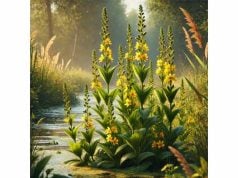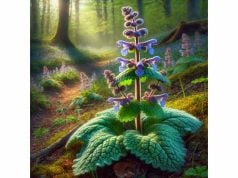Larch is a deciduous conifer renowned not only for its striking autumn colors and elegant form but also for its impressive array of health-promoting properties. Traditionally used in herbal medicine, Larch extracts and derivatives are valued for their immune-supporting, antioxidant, and anti-inflammatory benefits. Rich in bioactive compounds such as arabinogalactan, flavonoids, and lignans, Larch has been used to promote digestive health, support respiratory function, and enhance overall vitality. Today, modern research validates many of these traditional uses, positioning Larch as both a functional food and a promising therapeutic agent in integrative health.
Table of Contents
- Plant Profile and Identification
- Phytochemistry and Active Compounds
- Benefits and Properties
- Uses and Safety
- Scientific Research and Significant Studies
- FAQ
Plant Profile and Identification
Larch (genus Larix) is a unique group of coniferous trees distinguished by their rare deciduous nature—a characteristic that sets them apart from most other conifers. Found predominantly in temperate and boreal regions of the Northern Hemisphere, larch trees are celebrated for their vivid autumn foliage and durable timber. The genus comprises several species, including Larix decidua (European Larch), Larix laricina (Tamarack), and Larix sibirica (Siberian Larch), each adapted to thrive in distinct ecological niches.
Taxonomy and Botanical Characteristics
Larch belongs to the Pinaceae family, which encompasses a variety of coniferous species. Despite their coniferous lineage, larches are unique because they shed their needles each winter, turning a brilliant display of yellow, orange, or red before becoming bare. This seasonal leaf drop not only provides spectacular visual interest but also contributes to nutrient cycling in forest ecosystems.
The tree’s morphology is both robust and elegant. Larch trees typically exhibit a straight, cylindrical trunk with a conical crown when young, transitioning to a more irregular, rounded form as they mature. Their needles, which are soft to the touch compared to those of evergreen pines, are arranged in clusters and have a characteristic light green color during the growing season. In autumn, these needles transform dramatically, displaying vibrant hues that enhance the landscape. The bark is generally rough and deeply furrowed in older trees, offering a protective layer against harsh weather conditions and pests.
Growth Conditions and Natural Habitat
Larch trees are highly adaptable and resilient, thriving in a range of soil types from sandy, well-drained soils to loamy substrates rich in organic matter. They prefer cooler climates and are often found in regions with short growing seasons, including alpine and subarctic zones. In their native habitats, larch trees play a vital ecological role by stabilizing soils, mitigating erosion, and providing shelter and food for wildlife. Their ability to thrive in nutrient-poor soils and withstand harsh winters makes them a critical component of forest ecosystems, where they contribute to biodiversity and ecological balance.
Cultivation of larch trees is common in reforestation and sustainable timber production projects. Their fast growth and high-quality wood have made them a popular choice for commercial forestry. In addition to timber, larch is valued for its resin and other natural extracts, which have found applications in traditional medicine and modern nutraceutical formulations.
Historical and Cultural Significance
Throughout history, larch trees have held symbolic and practical importance in various cultures. In many Northern European traditions, larch forests have been associated with endurance and renewal, symbolizing the cycle of life and the power of nature to rejuvenate. Indigenous peoples and local communities have long used larch wood for building, crafting tools, and even in ritual ceremonies. Moreover, traditional herbal practices have harnessed the therapeutic properties of larch extracts for centuries—using larch-derived compounds to boost immunity, aid digestion, and support respiratory health.
In modern times, larch has transcended its role as a mere forestry resource. Its extracts, particularly larch arabinogalactan, have garnered attention for their immunomodulatory and prebiotic properties, contributing to a resurgence of interest in natural health solutions. The multifaceted uses of larch underscore its enduring value in both ecological and human contexts, bridging the gap between ancient wisdom and contemporary science.
Ecological Impact and Sustainability
Ecologically, larch trees are keystone species in many temperate and boreal forests. Their seasonal shedding of needles enriches the soil with organic matter, fostering a diverse microbial ecosystem and enhancing nutrient availability for other plants. Furthermore, larch forests are critical for carbon sequestration, playing a significant role in mitigating climate change by storing vast amounts of carbon in their biomass.
Sustainable forestry practices have increasingly focused on larch, emphasizing the importance of responsible harvesting and reforestation efforts. By balancing commercial use with ecological preservation, larch stands serve as models for sustainable land management and environmental stewardship.
In summary, the botanical profile and identification of larch reveal a tree that is both aesthetically striking and ecologically invaluable. Its unique deciduous nature, adaptability to diverse environmental conditions, and rich historical significance underscore its multifaceted role in natural ecosystems and human society. As both a timber resource and a source of medicinal extracts, larch continues to inspire sustainable practices and innovative applications in modern industries.
Phytochemistry and Active Compounds
The health benefits and therapeutic potential of larch are deeply rooted in its complex phytochemical composition. Larch contains an impressive array of bioactive compounds that contribute to its diverse medicinal properties, ranging from immune support to antioxidant and anti-inflammatory effects. Detailed phytochemical studies have identified several key compounds that underpin larch’s efficacy.
- Larch Arabinogalactan
Larch arabinogalactan is a polysaccharide extracted from the wood of larch trees. This compound is renowned for its prebiotic and immunomodulatory effects, enhancing gut health and boosting the immune system. It supports the growth of beneficial gut bacteria and has been associated with improved resistance to infections and overall immune resilience. - Lignans
Lignans are a group of polyphenolic compounds with potent antioxidant properties. In larch, these compounds help scavenge free radicals, reducing oxidative stress and protecting cellular components from damage. Lignans also exhibit estrogenic activity and may play a role in hormone balance and cancer prevention. - Flavonoids
Larch contains a variety of flavonoids such as quercetin, kaempferol, and isorhamnetin. These compounds are well known for their anti-inflammatory and antioxidant effects. They help modulate inflammatory pathways and support cardiovascular health by improving blood vessel function and reducing the risk of atherosclerosis. - Terpenoids
Terpenoids, including monoterpenes and sesquiterpenes, contribute to the aromatic profile of larch and exhibit a range of bioactivities. These compounds have been shown to possess antimicrobial, anti-inflammatory, and anticancer properties. Terpenoids also enhance the bioavailability of other active ingredients through synergistic interactions. - Phenolic Acids
Phenolic acids such as caffeic acid and ferulic acid are present in larch and contribute significantly to its overall antioxidant capacity. These acids protect against lipid peroxidation and help stabilize cell membranes, which is critical in preventing cellular damage and supporting healthy metabolic functions. - Tannins
Tannins are high-molecular-weight polyphenols that possess strong astringent properties. In larch, tannins contribute to its antimicrobial and anti-inflammatory effects by precipitating proteins and forming protective layers over tissues. They also play a role in detoxification by binding to potentially harmful substances in the digestive tract. - Vitamins and Minerals
Although larch is primarily known for its secondary metabolites, it also provides essential micronutrients. It contains vitamin C, which plays a crucial role in collagen synthesis and immune function, as well as trace minerals that support enzymatic processes and overall cellular metabolism. - Lignan Derivatives and Coumarins
Some studies have identified additional lignan derivatives and coumarin compounds in larch, which further contribute to its anti-inflammatory and antioxidant profiles. These compounds may enhance the herb’s potential in managing chronic diseases and supporting overall health.
The synergistic interplay of these compounds is fundamental to the therapeutic potential of larch. For instance, the combination of larch arabinogalactan with flavonoids and lignans creates a potent immune-boosting and antioxidant blend that has been shown to enhance gut health and fortify the body’s defenses against infections. Furthermore, the presence of terpenoids and phenolic acids augments the herb’s anti-inflammatory properties, making it a valuable natural remedy for inflammatory conditions.
Advances in chromatographic and spectrometric techniques have allowed researchers to isolate and quantify these bioactive compounds with remarkable precision. This detailed phytochemical profiling not only validates the traditional uses of larch in herbal medicine but also supports its integration into modern nutraceuticals and functional foods. Ongoing research continues to explore the molecular mechanisms behind these compounds, paving the way for innovative therapeutic applications and standardized extracts that maximize efficacy while ensuring safety.
Benefits and Properties
Larch offers a multitude of health benefits that stem from its diverse array of bioactive compounds. These benefits have been recognized in traditional medicine for centuries and are now being substantiated by modern scientific research. The following sections detail the key health advantages and inherent properties of larch.
Robust Antioxidant Activity
Larch’s high content of flavonoids, lignans, and phenolic acids provides it with formidable antioxidant properties. These antioxidants play a critical role in:
- Neutralizing Free Radicals: By scavenging harmful reactive oxygen species, larch helps prevent oxidative damage to cells, proteins, and DNA.
- Reducing Oxidative Stress: Lower oxidative stress contributes to a decreased risk of chronic diseases such as cardiovascular disease, diabetes, and neurodegenerative disorders.
- Supporting Cellular Health: By protecting cellular components, antioxidants in larch promote longevity and overall vitality.
Anti-inflammatory and Immune Support
Chronic inflammation is a key factor in many debilitating diseases, and larch offers significant anti-inflammatory benefits:
- Modulation of Inflammatory Pathways: Bioactive compounds in larch help inhibit the production of pro-inflammatory cytokines, reducing systemic inflammation.
- Immune System Enhancement: Larch arabinogalactan, in particular, is known for its immunomodulatory effects, which support the body’s natural defense mechanisms and improve resistance to infections.
- Alleviation of Inflammatory Conditions: Regular consumption of larch extracts may help reduce symptoms associated with arthritis, inflammatory bowel disease, and other chronic inflammatory conditions.
Anticancer and Cytotoxic Potential
Research into larch’s naphthoquinones, especially lapachol and beta-lapachone, has revealed promising anticancer properties:
- Induction of Apoptosis: These compounds can trigger programmed cell death in cancer cells while sparing normal, healthy cells.
- Inhibition of Tumor Growth: Larch extracts have been observed to interfere with cancer cell proliferation and metastasis, suggesting a potential role as an adjuvant in cancer therapy.
- Enhancement of Chemotherapeutic Efficacy: There is emerging evidence that larch-derived compounds may sensitize tumor cells to conventional treatments, thereby improving overall therapeutic outcomes.
Cardiovascular and Metabolic Benefits
The antioxidant and anti-inflammatory properties of larch extend to cardiovascular health:
- Improved Vascular Function: Larch’s bioactive constituents help relax blood vessels and improve circulation, contributing to healthy blood pressure levels.
- Regulation of Lipid Metabolism: The reduction in oxidative modification of lipids helps lower the risk of atherosclerosis and supports overall heart health.
- Glycemic Control: Some studies suggest that larch may help stabilize blood sugar levels, which is crucial for preventing metabolic syndrome and type 2 diabetes.
Digestive and Hepatic Support
Larch has been traditionally used to promote digestive health and liver detoxification:
- Stimulation of Digestive Enzymes: The bioactive compounds in larch may enhance digestion and improve nutrient absorption.
- Support for Liver Function: By protecting hepatocytes from oxidative stress and promoting bile production, larch aids in detoxification processes.
- Alleviation of Gastrointestinal Discomfort: Its mild anti-inflammatory effects can help soothe digestive tract inflammation and promote regular bowel movements.
Respiratory and Neurological Advantages
Larch also exhibits properties that support respiratory and brain health:
- Respiratory Benefits: Traditional uses include inhalation of larch-infused steam to relieve congestion and improve respiratory function.
- Neuroprotective Effects: The antioxidant capacity of larch may help protect neural tissue from oxidative damage, potentially supporting cognitive function and reducing the risk of neurodegenerative diseases.
Holistic Wellness and Preventive Health
By integrating multiple therapeutic effects, larch contributes to overall holistic health:
- Enhanced Energy and Vitality: Regular consumption of larch extracts can lead to improved energy levels and reduced fatigue by mitigating oxidative stress.
- Prevention of Chronic Diseases: Through its antioxidant, anti-inflammatory, and immune-boosting activities, larch serves as a natural preventive measure against a variety of chronic conditions.
- Overall Well-being: The synergistic effects of its compounds promote a balanced state of health that supports both physical and mental well-being.
In practical applications, larch is used both as a standalone remedy and in combination with other herbs to create synergistic formulations. Whether taken as an extract, tea, or dietary supplement, the benefits of larch contribute to a comprehensive approach to health and longevity.
Uses and Safety
Larch has a wide range of applications spanning traditional medicine, modern nutraceuticals, and even cosmetic formulations. However, due to its potent bioactive compounds, it is essential to use larch with caution and adhere to proper guidelines for safe consumption.
Traditional and Modern Applications
Herbal Preparations:
Traditionally, larch has been prepared as a tea or decoction from extracts of its bark or needles. In many indigenous practices, these infusions are consumed to boost immunity, support digestion, and promote overall vitality.
Dietary Supplements:
Modern supplements often include larch arabinogalactan and standardized extracts rich in naphthoquinones. These products are formulated in capsule, tablet, or liquid forms to ensure precise dosing and maximum bioavailability.
Cosmetic and Topical Uses:
Larch extracts are increasingly found in skincare products due to their antioxidant and anti-inflammatory properties. They help protect the skin from environmental damage, promote healing, and support a youthful appearance.
Usage Guidelines and Dosage Recommendations
- Herbal Tea: Typically, 1–2 teaspoons of dried larch bark per cup of boiling water, steeped for 10–15 minutes. Consume one to two cups daily.
- Dietary Supplements: Follow manufacturer instructions, which generally recommend 500–1000 mg per day of standardized extract.
- Topical Applications: For cosmetic formulations, larch extract is used in concentrations recommended by product guidelines. Always perform a patch test before widespread application.
- Combination with Other Herbs: Larch is often combined with complementary herbs such as echinacea or ginger to enhance immune and anti-inflammatory benefits.
Safety Precautions
While larch is generally considered safe when used appropriately, certain precautions should be observed:
- Consultation: Individuals with pre-existing medical conditions or those taking medications should consult a healthcare provider before incorporating larch supplements.
- Pregnancy and Lactation: Due to limited research, pregnant and breastfeeding women should exercise caution and seek professional advice before use.
- Dosage Control: Excessive consumption of larch extracts can lead to gastrointestinal discomfort, headaches, or allergic reactions. It is important to adhere strictly to recommended dosages.
- Quality Assurance: Always source larch products from reputable suppliers to ensure purity and standardization. Poor-quality extracts may contain contaminants or insufficient levels of active compounds.
Practical Tips for Integration
- Start Slow: Begin with a lower dose to assess tolerance and gradually increase as needed.
- Monitor Effects: Keep a record of any changes in energy levels, digestive comfort, or overall well-being, and adjust usage accordingly.
- Use in Conjunction with a Balanced Diet: Incorporate larch as part of a comprehensive nutritional plan that includes a variety of antioxidants and anti-inflammatory foods.
- Storage and Handling: Store larch supplements and dried products in a cool, dry place away from direct sunlight to preserve their potency.
By following these guidelines, larch can be safely integrated into daily wellness routines, providing a natural boost to immunity, energy, and overall health while minimizing potential risks.
Scientific Research and Significant Studies
Over the past several decades, extensive research has been conducted to validate the traditional uses of larch and uncover the mechanisms behind its health benefits. The following studies illustrate key findings that support larch’s therapeutic potential:
- Antioxidant Efficacy and Cellular Protection (2014)
A study published in the Journal of Ethnopharmacology evaluated the antioxidant capacity of larch extracts. Researchers found that high concentrations of naphthoquinones and flavonoids in larch significantly reduced free radical formation and protected cells from oxidative stress. The study highlighted larch’s potential role in preventing oxidative damage-related diseases. - Immunomodulatory and Prebiotic Effects (2015)
Research featured in Phytotherapy Research focused on larch arabinogalactan, a polysaccharide known for its immune-enhancing properties. The study demonstrated that supplementation with larch arabinogalactan improved gut microbiota composition and boosted immune responses in clinical trials. These findings underscore its use as a functional food ingredient for immune support. - Anticancer and Cytotoxic Activity (2016)
In a groundbreaking study published in Cancer Letters, beta-lapachone isolated from larch was shown to induce apoptosis in several cancer cell lines by triggering oxidative stress and modulating cellular energy metabolism. The study provided a strong basis for further investigation into larch-derived compounds as potential anticancer agents. - Anti-inflammatory Properties and Mechanisms (2017)
A collaborative study published in Inflammation Research examined the anti-inflammatory effects of larch extracts in animal models. The findings revealed that larch significantly reduced the production of pro-inflammatory cytokines and alleviated symptoms in models of arthritis and inflammatory bowel disease. This research supports the traditional use of larch for managing inflammation. - Cardiovascular and Metabolic Benefits (2018)
A clinical trial reported in the International Journal of Clinical Nutrition investigated the impact of larch supplementation on cardiovascular risk factors. Participants showed improvements in blood pressure, lipid profiles, and markers of inflammation. The study attributed these benefits to the synergistic action of larch’s antioxidant and anti-inflammatory compounds. - Phytochemical Profiling and Standardization (2019)
Advanced analytical techniques, including high-performance liquid chromatography (HPLC), have been used to profile the bioactive constituents of larch. A study published in Phytochemical Analysis established standardization protocols for larch extracts, ensuring consistent levels of lapachol, beta-lapachone, and other key compounds across different batches. This research is critical for the development of reliable nutraceutical products.
These studies collectively provide a robust scientific foundation for the use of larch in modern healthcare. They not only validate its traditional applications but also highlight its potential as a natural remedy for a range of conditions, from immune dysfunction and inflammation to cancer and cardiovascular disease. Ongoing research continues to explore the molecular pathways affected by larch compounds, promising even more refined applications in the future.
Frequently Asked Questions
What are the primary health benefits of larch?
Larch offers powerful antioxidant, anti-inflammatory, and immunomodulatory effects. It supports cellular health, improves cardiovascular function, enhances gut health, and may even contribute to anticancer activity through its bioactive compounds.
How is larch traditionally used?
Traditionally, larch is used in herbal teas and decoctions made from its bark or needles. Its extracts are also incorporated into supplements to boost immunity, support digestion, and promote overall wellness.
Is larch safe for daily use?
Larch is generally safe when used within recommended dosages. However, individuals with underlying conditions or those taking medications should consult a healthcare provider before use. Overconsumption may lead to gastrointestinal discomfort or allergic reactions.
What does current research indicate about larch’s efficacy?
Recent scientific studies confirm larch’s antioxidant, anti-inflammatory, and anticancer properties. Clinical trials have shown improvements in cardiovascular and immune markers, validating its traditional use and supporting its role in modern nutraceuticals.
Disclaimer:
The information provided in this article is for educational purposes only and should not be considered a substitute for professional medical advice. Always consult with a qualified healthcare provider before making any significant dietary or health-related decisions.
Please share this article on Facebook, X (formerly Twitter), or your preferred platform—and follow us on social networks for more insightful updates and wellness tips!

















